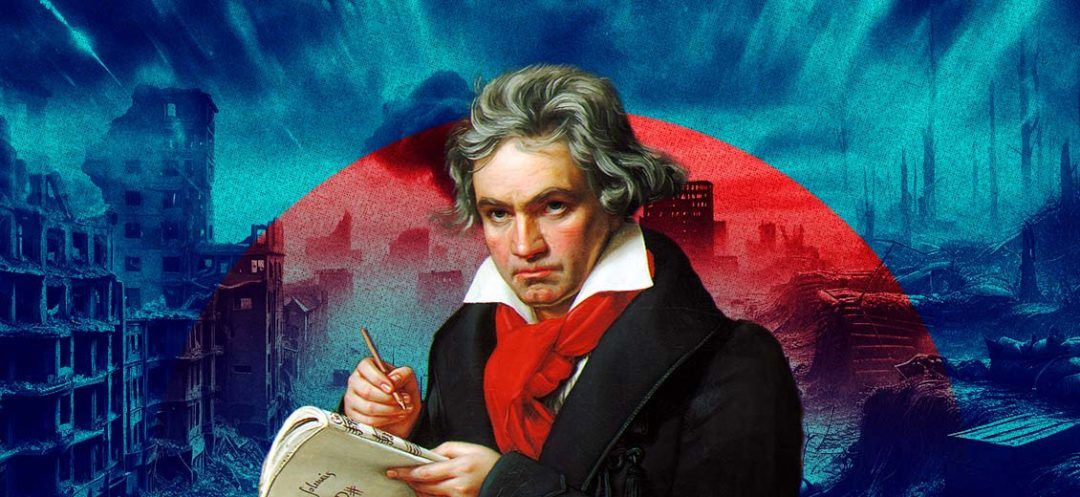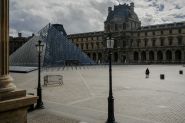
Composers of Western art music have depicted the tragedy of war through various musical works while yearning for long-awaited peace. The first article of this series will cover three of Beethoven’s works, as we commemorate the bicentennial of the 9th Symphony.
War rages still, in the four corners of the world. A de facto truth, some would say, while others believe it is a battle in the name of God. But little does it matter. You can try all you want to ornament a bloodbath with the noble concepts of justice or sanctity, but a bloodbath is immutably macabre, a menacing specter of horror, desolation, ruin, and chaos. No matter how noble an enterprise is, it is bound to lose its legitimacy when fire and gunpowder are the means used. Truth and justice cannot prevail with violence and blood. Such is the vision that countless composers of Western art music have endeavored to convey through the centuries. Their creations depict the brutality of war, laying bare the cruelty of Man. This series will shed light on Ludwig van Beethoven (1770-1827) and Dmitri Shostakovich (1906-1975), two great composers who reflected deeply on the concept of war.
Beethoven studied the theme of war on three occasions, starting with Wellington’s Victory in Op.91, in 1813. Back then, Europe was torn apart by the Napoleonic wars that profoundly impacted the daily cultural life of the German master and his contemporaries. Beethoven was a solid proponent of freedom and national independence, and Napoleon’s defeat in Vitoria marked a pivotal change in the struggle against French imperial expansionism. In this work, Beethoven highlights two warring armies, each having its musical theme; God Save the King, evidently, for the British army. As for the French, since it was inconceivable for Beethoven to degrade the Marseillaise – his ideal of revolution – he would opt, laughably, for the popular song Malbrough s’en va-t-en guerre (Marlborough is going off to war).
The French musicologist and famous Beethoven scholar, Bernard Fournier, stated “In this work, Beethoven not only resorts to a large orchestra (drums, big crates, cannons, etc.), but also requests and implements a spatialization of sound sources.” For example, when the assault (Sturm Marsch) begins, the English drums are sent in from the French side. “This work, that ‘experiments with space’, establishes a program of dynamic spatialization,” the expert insists while explaining that “the illusion of movement is generated not only through the crescendo (as in Fidelio with the minister’s trumpet that, backstage, is played piano then forte), but also by the movement of some instrumentalists who travel from one side of the orchestra to the other.” Beethoven innovates even in this relatively minor musical work.
Following this lifelike musical representation of war, Beethoven depicts an allegorical image of the war through the second movement of the 9th Symphony. “After the dramatic first movement (Allegro ma non troppo, un poco maestoso) where pain and anguish reach their peak in the coda’s funeral march, the Scherzo (Molto vivace) conveys the energy that emanates from the struggle to overcome adversity,” the French states, dissecting the enormous symphony in D minor. The kettledrums that give off a combative feel play a crucial, thematic role. The rhythmic cell they enunciate in the very beginning spans the entire movement and reverberates repeatedly over a long sequence.
“After the double variations of the third movement (Adagio molto e cantabile – Andante moderato) that bring peace and serenity following the battle, the Finale comes in. The first orchestral part of it periodically jolts out in a recitative of low-pitched chords the main Stimmungen (“states of mind”, in German) from the previous movements – pain, combativeness, peace – in order to exult joy,” Bernard Fournier adds. Beethoven then makes use of a choir and four soloists to interpret the poem of Friedrich Schiller (1759-1805), in which this bliss is celebrated as a universal link between all human beings. The piece would be sung in many variations, showcasing its multiple aspects. The 9th Symphony, which conveys the ideals of brotherhood and human unity, remains one of the most famous compositions of the genius from Bonn.
In the video shared below, the Swedish conductor and dean of conductors, Herbert Blomstedt (who turned 97 on July 11, 2024), leads Leipzig’s Gewandhaus orchestra.
“But where war is most massively present is in Dona nobis pacem (“give us peace”) from Missa Solemnis, comprising two parts that represent war and inner conflict,” the eighty-year-old musicologist says. In fact, Beethoven titled this second part of his Agnus Dei “A prayer for outer and inner peace.” According to Bernard Fournier, the call for outer peace stems from the martial section of Dona Nobis Pacem, through the scream of the solo soprano following a terrifying depiction of war made possible by the appropriate use of trumpets and kettledrums. This war would echo again in the coda where the kettledrum rolls finally reemerge as a faint, distant sound, highlighting the idea that the outer war is not really over, despite the necessity of prayer and the poignant calls of Dona nobis pacem.
War rages still, in the four corners of the world. A de facto truth, some would say, while others believe it is a battle in the name of God. But little does it matter. You can try all you want to ornament a bloodbath with the noble concepts of justice or sanctity, but a bloodbath is immutably macabre, a menacing specter of horror, desolation, ruin, and chaos. No matter how noble an enterprise is, it is bound to lose its legitimacy when fire and gunpowder are the means used. Truth and justice cannot prevail with violence and blood. Such is the vision that countless composers of Western art music have endeavored to convey through the centuries. Their creations depict the brutality of war, laying bare the cruelty of Man. This series will shed light on Ludwig van Beethoven (1770-1827) and Dmitri Shostakovich (1906-1975), two great composers who reflected deeply on the concept of war.
Dynamic Spatialization
Beethoven studied the theme of war on three occasions, starting with Wellington’s Victory in Op.91, in 1813. Back then, Europe was torn apart by the Napoleonic wars that profoundly impacted the daily cultural life of the German master and his contemporaries. Beethoven was a solid proponent of freedom and national independence, and Napoleon’s defeat in Vitoria marked a pivotal change in the struggle against French imperial expansionism. In this work, Beethoven highlights two warring armies, each having its musical theme; God Save the King, evidently, for the British army. As for the French, since it was inconceivable for Beethoven to degrade the Marseillaise – his ideal of revolution – he would opt, laughably, for the popular song Malbrough s’en va-t-en guerre (Marlborough is going off to war).
The French musicologist and famous Beethoven scholar, Bernard Fournier, stated “In this work, Beethoven not only resorts to a large orchestra (drums, big crates, cannons, etc.), but also requests and implements a spatialization of sound sources.” For example, when the assault (Sturm Marsch) begins, the English drums are sent in from the French side. “This work, that ‘experiments with space’, establishes a program of dynamic spatialization,” the expert insists while explaining that “the illusion of movement is generated not only through the crescendo (as in Fidelio with the minister’s trumpet that, backstage, is played piano then forte), but also by the movement of some instrumentalists who travel from one side of the orchestra to the other.” Beethoven innovates even in this relatively minor musical work.
From War to Bliss
Following this lifelike musical representation of war, Beethoven depicts an allegorical image of the war through the second movement of the 9th Symphony. “After the dramatic first movement (Allegro ma non troppo, un poco maestoso) where pain and anguish reach their peak in the coda’s funeral march, the Scherzo (Molto vivace) conveys the energy that emanates from the struggle to overcome adversity,” the French states, dissecting the enormous symphony in D minor. The kettledrums that give off a combative feel play a crucial, thematic role. The rhythmic cell they enunciate in the very beginning spans the entire movement and reverberates repeatedly over a long sequence.
“After the double variations of the third movement (Adagio molto e cantabile – Andante moderato) that bring peace and serenity following the battle, the Finale comes in. The first orchestral part of it periodically jolts out in a recitative of low-pitched chords the main Stimmungen (“states of mind”, in German) from the previous movements – pain, combativeness, peace – in order to exult joy,” Bernard Fournier adds. Beethoven then makes use of a choir and four soloists to interpret the poem of Friedrich Schiller (1759-1805), in which this bliss is celebrated as a universal link between all human beings. The piece would be sung in many variations, showcasing its multiple aspects. The 9th Symphony, which conveys the ideals of brotherhood and human unity, remains one of the most famous compositions of the genius from Bonn.
In the video shared below, the Swedish conductor and dean of conductors, Herbert Blomstedt (who turned 97 on July 11, 2024), leads Leipzig’s Gewandhaus orchestra.
Outer and Inner Peace
“But where war is most massively present is in Dona nobis pacem (“give us peace”) from Missa Solemnis, comprising two parts that represent war and inner conflict,” the eighty-year-old musicologist says. In fact, Beethoven titled this second part of his Agnus Dei “A prayer for outer and inner peace.” According to Bernard Fournier, the call for outer peace stems from the martial section of Dona Nobis Pacem, through the scream of the solo soprano following a terrifying depiction of war made possible by the appropriate use of trumpets and kettledrums. This war would echo again in the coda where the kettledrum rolls finally reemerge as a faint, distant sound, highlighting the idea that the outer war is not really over, despite the necessity of prayer and the poignant calls of Dona nobis pacem.
Read more




Comments